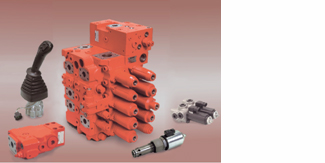Freely Manipulating Hydraulic Fluid
Hydraulic fluid sent out from a hydraulic pump is introduced into actuators such as hydraulic cylinders or hydraulic motors, where it is converted into a driving force or rotational force so that work can be performed.
There are various kinds of hydraulic valves in the channels that the hydraulic fluid flows through including the pressure control valve that controls the generated pressure, flow control valve that controls the flow supplied to each actuator, and direction control valve that controls distribution of the hydraulic fluid.
In order to control actuators smoothly and freely, it is important to not only improve the performance of the hydraulic valves themselves, but design the entire hydraulic circuit taking the relationships among the valves into consideration.
For example, for the design of the multiple control valve, which is very important as it determines the operability of a hydraulic excavator, technologies such as flow analysis using computational fluid dynamics (CFD) and various response analyses using simulation software are utilized, aiming at enhancement of its performance and operability.

Multiple control valve for a mid-size excavator, etc.





